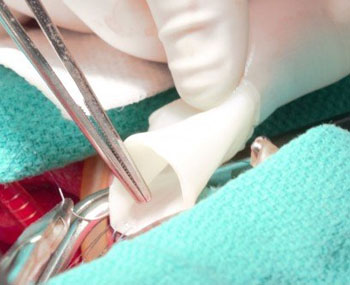Novel Graft Material Grows with Young Transplant Recipients
By LabMedica International staff writers
Posted on 11 Oct 2016
In a "proof-of-concept" paper, a team of biomedical engineers described a novel "off-the shelf" material for grafting blood vessels that is able to grow and mature along with the young patient recipients.Posted on 11 Oct 2016
Treatment of congenital heart defects in children requiring right ventricular outflow tract reconstruction typically involves multiple open-heart surgeries because all existing graft materials have no growth potential. In an attempt to develop a type of graft material that would grow along with the recipient, investigators at the University of Minnesota (Minneapolis/St. Paul, USA) worked with a young sheep model.

Image: An “off-the-shelf” material that can grow in the body has the potential to prevent the need for repeated surgeries in some children with congenital heart defects (Photo courtesy of the University of Minnesota).
The graft material was produced by growing donor sheep skin cells in fibrin-based gelatin tubes maintained in bioreactors with pumping of nutrients necessary for cell growth. Pumping provided both nutrients and stimulation to strengthen and stiffen the tubes. After five weeks of growth, detergents were used to wash away the sheep cells, leaving behind a cell-free matrix that would not cause a immune reaction when implanted.
The decellularized material was characterized, stored, and then implanted into three lambs (average age eight weeks), tracked longitudinally with ultrasound, and then explanted after the lambs reach adult size (age 50 weeks) for mechanical, biochemical, and histological characterization.
Results published in the September 27, 2016, online edition of the journal Nature Communications revealed that the lambs showed normal growth, increasing body weight by 366% and graft diameter and volume by 56% and 216%, respectively. Explanted grafts displayed physiological strength and stiffness, complete lumen endothelialization, and extensive population by mature smooth muscle cells. The grafts also showed substantial elastin deposition and a 465% increase in collagen content, without signs of calcification, aneurysm, or stenosis.
“What is important is that when the graft was implanted in the sheep, the cells repopulated the blood vessel tube matrix,” said senior author Dr. Robert Tranquillo, professor of biomedical engineering at the University of Minnesota. “If the cells do not repopulate the graft, the vessel cannot grow. This is the perfect marriage between tissue engineering and regenerative medicine where tissue is grown in the lab and then, after implanting the decellularized tissue, the natural processes of the recipient’s body make it a living tissue again. This might be the first time we have an ‘off-the-shelf’ material that doctors can implant in a patient, and it can grow in the body. In the future, this could potentially mean one surgery instead of five or more surgeries that some children with heart defects have before adulthood.”
Related Links:
University of Minnesota














